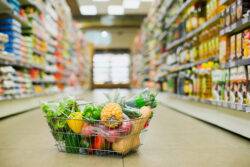Keep an eye on your perishables when you’re shopping online (Picture: Getty Images)
For millions of us online grocery shopping is invaluable, making life easier for those of us who can’t get to the supermarket to stock up.
Whether you use the service due to disability, lack of transport or simply for convenience if you don’t have time to go in person, it’s become hugely popular in recent years – with Statista research from 2022 suggesting more than half of people now do their grocery shopping online.
However, there can sometimes be a down side to having your goods delivered to your doorstep, when it comes to use by dates.
Since you’re having your groceries chosen for you instead of picking them out yourself in the supermarket, use by dates can be less predictable, and you might find yourself receiving products with a short shelf-life.
Which, given the current cost of living crisis, might not be ideal if you’re trying to cut down on food waste.
So are groceries ordered online really being delivered close to their use-by dates? And which products are most likely be affected?
Are groceries delivered online near use-by dates?
There’s no one set answer to this, but it would appear to depend on what you’re ordering and where you’re ordering it from.
Consumer experts Which have carried out an investigation into this, ordering 25 items with use-by dates from six major supermarkets – Asda, Morrisons, Ocado, Sainsbury’s, Tesco and Waitrose – and then comparing dates on what was received.
Researchers then added up the number of full hours remaining from the time of delivery until midnight on each item to determine which of the six sent out products with the closest use-by dates.
Shelf-life can vary so check your delivery carefully (Picture: Getty Images)
They discovered there was little difference between any of them – with a gap of 38 hours for the longest and shortest gap on perishable items – although some specific items did vary.
Sainsbury’s products were found to have the shortest shelf-life, with an average of 9.7 days – while Ocado was the best with an average 11.2 days.
When it came to individual products Sainsbury’s delivered one item – a packet of chilled frankfurters – which were 11 days past their use by date. A quiche, meanwhile, arrived just six hours before its use by date expired.
A Sainsbury’s spokesperson said: ‘We deliver more than 85,000 orders a day on average and are sorry that this tiny number of examples has not lived up to our usual high service.’
Other items close to their use-by date delivered by the supermarkets included pre-cut melon and pineapple, which was one or two days before its use-by date, and stilton with just a couple of days left before it was due to expire – or, in the case of Asda, three days out of date.
By contrast, Sainsbury’s stilton had 37 days to go until its use-by date – the longest amount of time on any of the items ordered.
Which items have the longest and shortest shelf-life?
Speaking on their podcast, Which senior researcher and writer Ellie Simmonds explained that dairy products tended to have longer dates when ordered online, while pre-cut fresh fruit and veg was less of a safe bet.
‘It’s generally a safe bet to order cheese, yoghurt or cream online if you’re after products that don’t need to be consumed imminently,’ she said on the podcast.
Sainsbury’s products had the longest and the shortest shelf lives (Picture: Getty Images)
‘Pre-cut fresh fruit and veg tend not to have a long life, so it’s best to plan to eat meals involving these types of products as soon as possible after your delivery.’
‘If buying food with a decent shelf life is a priority, it’s worth noting that people who shop in-store are more satisfied with the freshness of their groceries than those who opt for online deliveries.
‘That’s probably because when you’re in the supermarket you’re able to pick the items with the longest shelf-life.’
What’s the difference between Use By and Best Before?
Use by is about food safety. Usually, it’s provided on fresh, highly perishable products such as fish or chicken. Eating something after the specified use by date is considered unsafe.
The UK’s Food Standards Agency says you shouldn’t eat foods after their use by date, even if it looks and smells OK – as beyond the use by date there is the potential for harmful bacteria to grow.
Use by and best before are two very different things (Picture: Getty Images)
Best before is not about safety, but signifies when the food is of the highest quality.
In general, you can still eat the food after the best before date, but the quality may not be as good as it was when you bought it – for example the texture may have changed, or it may not taste as good.
If you are sent something in your online shop which is past its use by date, you should return it to your delivery driver for a refund, or contact the store directly.





